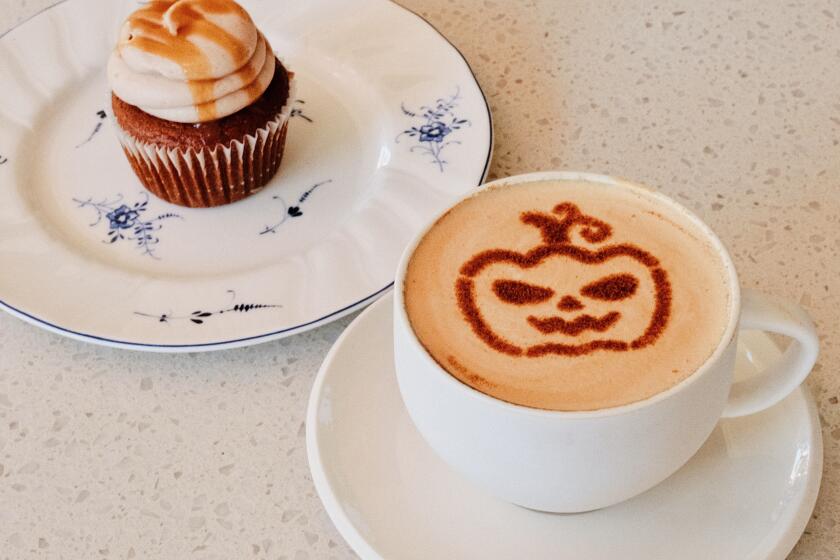Hold the Sushi
COSTA MESA — In the men’s washroom at Hana No Ki, there is a lithograph of Picasso’s “Femme Endormie” (A Woman Sleeping). Picasso’s elegant figure is a single-line drawing executed with simplicity and unaffected grace. These are the very essence of great Japanese cuisine.
Hana No Ki (the name means flowering tree) comes upon you modestly--it is marked only with an overhead sign reading “Japanese Restaurant.” The specialty here is kappo, the pub dishes that complement beer and sake.
Hana No Ki does not serve sushi. On one occasion, I saw the chef bristle when a customer requested a California roll. On another, the restaurant’s lone waitress had to explain patiently why two standbys of sushi restaurants--wasabi horseradish and sliced red ginger--had not been brought out. But this is not a matter of concern, since chef Tomohiko Munakato cooks at a level few ethnic restaurants in Orange County can even dream about.
The restaurant is simple and spare. You’ll experience his consummate skill in a postage stamp-sized dining area furnished only with five tables, a four-stool counter and a row of blue cloth curtains that are used to hide part of the kitchen.
Most of the customers here are Japanese businessmen well aware of the kitchen’s repertory and the complicated etiquette involved in ordering a proper Japanese pub meal. (Anything made with rice is reserved for the end.)
The regulars do not have any trouble reading the Japanese language specials blackboard or the paper banners inscribed with names of the many pub dishes. But for anyone who can’t read Japanese, getting the best out of a meal at Hana No Ki requires a little help from Japanese friends. There are limited lunch and dinner menus printed in English, but the real action is on the blackboard and those illegible banners.
One wonderful item that has made its way onto the English-language dinner menu is tatami iwashi. It’s a rectangular palm-sized mat with curled edges, and you might at first take it for a potato galette, until you see a delicate woven pattern; this mat is made from nothing but shredded sardines. And it’s just terrific with a splash of the Japanese lime called yuzu, and a cold beer on the side.
Like any kappo chef worth his salt, Munakato excels in the preparation of seafoods. His version of white Norwegian mackerel (shime saba) is thinly sliced and seared around the edges, and I’ve never tasted better. A Japanese friend who accompanied me was reluctant to have me order it. She felt this fish is “too oily and salty for Americans,” as she put it. One mouthful, though, and I was won over. Shime saba has a meltingly soft texture and intensely briny flavors.
Even when it is not listed on the blackboard, the chef usually has gindara saikyoyaki on hand. Gindara is black cod, and this dish is a sizzling filet (skin on) that’s as soft as melting butter. The dish gets its name, and much of its flavor, from the fermented white bean paste saikyo miso. It’s also nicely perfumed with sake.
Still, there’s much more than plain seafood at Hana No Ki. On a given day there will be exquisite French-style green beans parboiled and tossed in a smoky bacon sauce. On another, the chef will prepare bay scallops--browned with spears of asparagus.
The best meat dish is rare beef (gyuuniku no tataki), generously marbled filet mignon, blood rare, served ice cold in thin slices. The beef is enhanced by its garnish: grated carrots, radishes and a pungent root vegetable known as myoga. Perhaps the humblest dish Munakato serves is niku jaga, a soy-flavored beef stew with chunks of potato. It’s a warm, filling dish that Japanese men associate with their grandmothers.
The end of a pub meal is when you’re supposed to satisfy any cravings for rice. You can get chazuke (rice and broth doused with hot tea), or a thicker, more substantial soup called zosui made with rice and some other ingredient, usually chicken, salmon or shiitake mushrooms. The chazuke and zosui are both great here, thanks to the chef’s wonderful stocks and broths.
At lunch (which is very busy), there is a daily special meal which is a remarkable value at $6.95. One day I had pickles, rice, miso soup, a delicious bowl of grilled beef with onions and a separate bowl of buckwheat noodles laced with a smoky broth. Another day, the beef was replaced by a mixed tempura of shrimp and vegetables.
Evenings are less crowded and feature a larger selection of kappo dishes, usually somewhere around 40. What is available depends on the season, what looks good in the market and the whim of the chef. It’s always worth checking out.
Los Angeles may have the sushi bars, but Orange County definitely measures up in the Japanese pub department. When the beer bottles are emptied and the sake is cooling, we can take them on any day.
Hana No Ki is moderately priced. Appetizers are $1.75 to $7.25. Light suppers are $4.95-$8.95. Complete dinners are $10.95-$12.95.
BE THERE
* Hana No Ki, 851 Baker St., B-15, Costa Mesa. (714) 557-8715. 11:30 a.m.-2 p.m. Monday-Friday; 5:30-10 p.m. Monday-Thursday, 5:30-midnight Friday-Saturday. Closed Sunday. MasterCard and Visa.
More to Read
Eat your way across L.A.
Get our weekly Tasting Notes newsletter for reviews, news and more.
You may occasionally receive promotional content from the Los Angeles Times.









